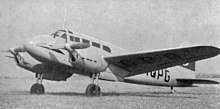Siebel Fh 104
| Fh 104 | |
|---|---|
 | |
| An Fh 104 with Albert Kesselring at the controls | |
| Role | Light transport, Communications, Liaison |
| National origin | Germany |
| Manufacturer | Siebel |
| First flight | 1937 |
| Primary user | Luftwaffe |
| Produced | 1937–1942 |
| Number built | 46 |
The Siebel Fh 104 Hallore was a small German twin-engined transport, communications and liaison aircraft built by Siebel.
Design and development
In 1934, the Klemm Leichtflugzeugbau set up a new factory at Halle, for production of all-metal aircraft (as opposed to Klemms normal wood and fabric light aircraft) and transferred the development of a new twin-engined transport, the Klemm Kl 104 to the Halle factory, the type being redesignated Fh 104. Klemm transferred control of the factory to Fritz Siebel in 1937, the year the Fh 104 prototype first flew.
It had a metal fuselage, plywood covered wings and a hydraulic undercarriage that retracted into the lower part of the engine nacelles. It became known as the 'Hallore' after the name given to those born in that city.
Performance
Fh 104s won long distance flying competitions in 1938 and an example flew 40,000 km around Africa in 1939. It won the principal award in the 1938 Littorio Rally.[1] During World War II the aircraft was used as a personal transport aircraft by some senior Wehrmacht officers and officials including Adolf Galland, Albert Kesselring and Ernst Udet. At least 15 aircraft appeared on the pre-war German civil register.[2]
The larger Siebel Si 204 was based on it.
Operators

- Czechoslovakian Air Force (Postwar)
- Luftwaffe
Specifications (Fh 104)
Data from German Aircraft of the Second World War [3]
General characteristics
- Crew: One or two pilots
- Capacity: Up to 5 passengers
- Length: 9.50 m (31 ft 2 in)
- Wingspan: 12.06 m (39 ft 7 in)
- Height: 2.64 m (8 ft)
- Wing area: 22.3 m² (240 ft²)
- Empty weight: 1,510 kg (3,329 lb)
- Loaded weight: 2,350 kg (5,181 lb)
- Powerplant: 2 × eight-cylinder inverted V Hirth HM 508, 209 kW (280 hp) each
Performance
- Maximum speed: at sea level 350 km/h (217 mph)
- Cruise speed: 335 km/h (208 mph)
- Range: 920 km (572 miles)
- Service ceiling: 6,600 m (21,650 ft)
- Rate of climb: [1] to 1,000 m (3050 ft) 6.0 m/s (1,090 ft/min)
See also
Related development
References
| Wikimedia Commons has media related to Siebel Fh 104. |
Notes
Bibliography
- Smith, J.R. and Kay, Antony J. German Aircraft of the Second World War. London:Putnam, 1990. ISBN 0-85177-836-4.